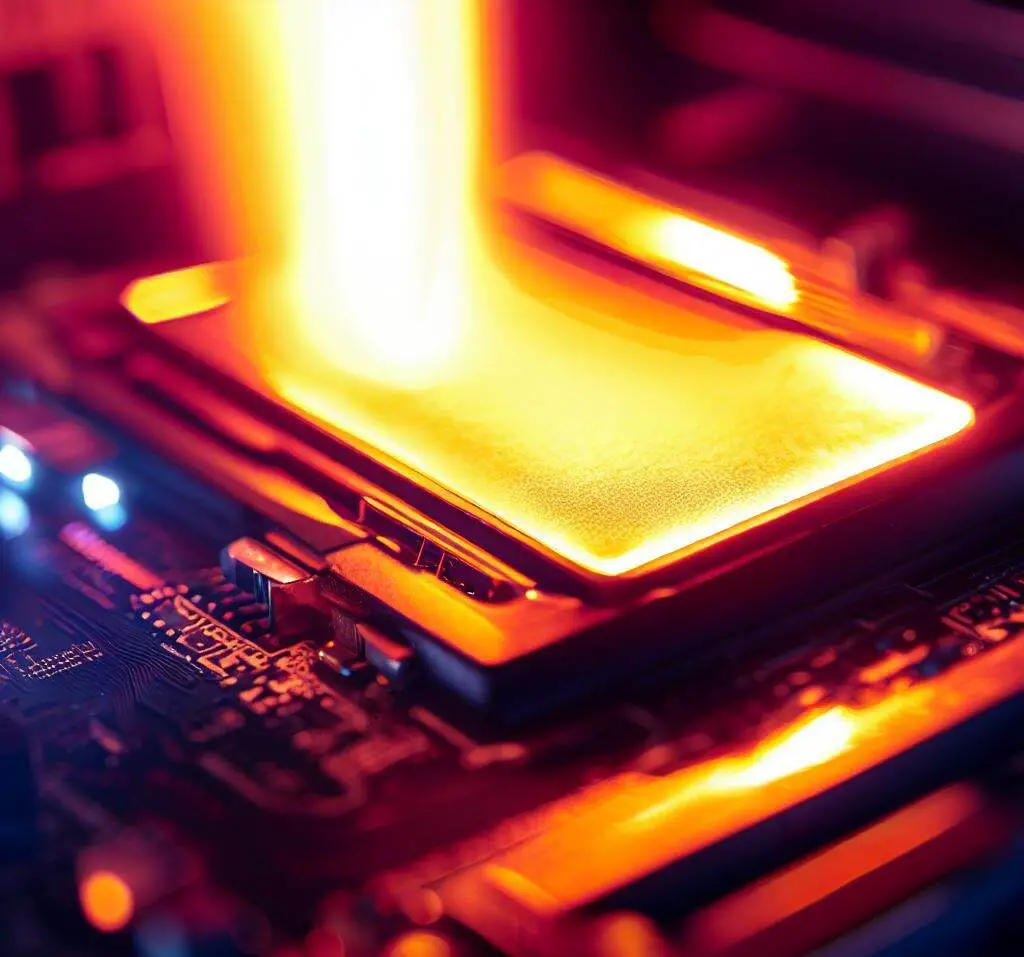With building PCs becoming more popular with each passing day, people are learning how different PC parts function. GPUs tend to run hot when processing graphically intensive tasks like gaming.
The ideal temperature for a GPU to run when under load is between 65–85° Celsius. But, if your GPU is running hotter than the 110° Celsius mark, your GPU is running too hot and is at risk of damaging itself or other PC components.
Quick Overview: “Good” GPU Temperature
Key Points:
- Ideal GPU temperature under load: 65–85° Celsius.
- GPUs might run hot when underperforming or due to physical issues like dust buildup or slow fan speed.
- Remedial Measures: Regular cleaning, checking fan speed, limiting background applications, and avoiding overclocking can help.
- Hardware issues: Damage to GPU or inadequate power supply can cause overheating. Consult a professional if necessary.
How Hot Should My GPU Run Normally?
How hot your GPU should be running is determined mainly by what tasks it’s currently performing. An idle GPU should naturally run cooler than one playing Crysis Remastered at 60 FPS.
When idling — that is, when your PC isn’t running anything besides the operating system — your GPU should not exceed a temperature of 65° Celsius. The average GPU temperature for an idle PC should be 40–65° Celsius.
Are There GPUs That Run Hot?
Some GPUs are known to run hot. The Radeon RX 5700 and 6000 series GPUs are rated to run up to 110° Celsius safely. Unlike other GPUs, their sensors won’t flag your GPU as running too hot until they reach that point.
What Happens When My GPU Overheats?
Your GPU will “overheat” when it reaches what’s known as a junction temperature. At this point, the GPU will begin to throttle itself and run at lower speeds to preserve its components and prevent heat damage. If the clock speed continues to ramp up, the PC will initiate a forced shutdown to avoid damage to any internal parts.
What Causes High GPU Temperatures?
There are many possible causes of high GPU temperatures. High temperatures can result from internal malfunction or external conditions that cause your GPU to run at a lower overall efficacy. Figuring out what’s causing your GPU to run at a high temperature is the first step to lowering the temperatures of your GPU and your entire system by proxy.
Dust & Dirt Build-Up
One of the most common causes of GPU heat spikes is build-ups of dust and dirt. These deposits trap heat and prevent the heatsink from adequately moving heat away from the GPU as they spin.
If it’s been a while since you last cleaned out the inside of your system, this might be an excellent place to start. Grab a can of compressed air and get to work blowing the dust off of your components.
Readers with extra cash to spend can grab a high-powered electronics vacuum and use it to get any dirt and dust built up off their components without damaging them.
Improper Fan Speed
Another common cause of excessively high GPU temperatures is the fan speed. The stock coolers for your GPU should be able to carry it safely through the majority of tasks that you can throw at it. However, some will throttle their fan speed to keep the fans quiet, resulting in unusually high GPU temperatures.
Check your fan speed curve in the proprietary software packaged with your GPU. If your fan curve is capped at an unnecessarily low speed, feel free to raise the speed to improve the efficacy of your GPU and protect it from heat damage.
Excess Background Applications and Processes
If your GPU doesn’t have any external forces causing it to overheat, like dust or an unusually slow fan speed, consider the internal processes instead. While the fan speed and dust build-up influence how quickly and efficiently the heat is moved away from your GPU, the number of tasks running will determine how hot your GPU runs in the first place.
When your GPU is running too many tasks—even small ones can build up!—you’ll be in a situation where your GPU is running hotter than it needs to. While things like browsing the internet and using Microsoft Word may seem like they shouldn’t take up too much memory, they can build up. Additionally, web pages have become increasingly more graphically intensive, and many automatically load high-definition photos and video, which can put unnecessary strain on your GPU.
Press CTRL + ALT + Delete to close any unnecessary tasks and select “Task Manager.” Navigate to the “Processes” tab, and from there, you can terminate any unnecessary processes. Make sure you don’t close the System or Explorer processes, as these are the core function processes of your operating system.
Stop Overclocking
Overclocking isn’t generally considered necessary in the world of computers, but many people like to do so to get more mileage out of the equipment they’ve purchased. However, overclocking can cause a more intensive wear-and-tear to your equipment in the long term. Most notably, overlocked CPUs and GPUs tend to run hotter and require more expensive cooling rigs (like that one guy who overclocked his CPU to 8 GHz and had to cool the system with liquid nitrogen to keep the temperatures down.)
While most GPUs will run at the stock clock speed out of the box, the tech may have overclocked your GPU if your PC was assembled for you. If your GPU is running unusually hot, check that it’s running at the stock clock speed.
Additionally, normal wear-and-tear can lower the efficacy of a GPU over time and require you to cap the clock speed below the stock speed. Once you’ve reached this point, the best thing you can do is replace the GPU. While you could replace the parts yourself or send them in for repairs, you might have better luck just replacing the whole component.
Your GPU Is Damaged
Your GPU may also be damaged. This could be especially true if your GPU were running fine until recently and slowly began to degrade. Normal wear-and-tear on your components will eventually affect the efficacy of the details as they run.
Suppose your GPU has come in contact with anything that might have caused unnecessary damage like liquids or static electricity. You may see a rapid decline in your GPU’s functionality that needs to be redressed.
One common way GPUs become “damaged” is the thermal paste attached to the processor drying up. Thermal paste transfers heat quickly from the Processing Unit to the air, where the fans whisk the heat away to keep temperatures down. If the GPU’s thermal paste dries up, the efficacy of the paste is lessened, and it’s unable to move heat as quickly as it needs to support higher task loads.
You can replace your GPU’s thermal paste at home, but before doing so, ensure that your GPU is still under warranty in case anything goes wrong.
Inadequate Power Supply
Other components can also influence the amount of heat produced by your GPU. Suppose your power supply isn’t producing enough energy to run your GPU at the clock speeds it needs to run at to complete the tasks you’ve started. It will labor running at lower clock speeds or run extra hot while trying to reach those higher necessary speeds.
Installing an inadequate power supply is usually the fault of an inexperienced PC builder that underestimates the amount of power needed to supply a new rig or an upgrade. The best thing you can do is replace your power supply. Attempting to run an inadequate power supply for too long will fail the power supply and could damage other components since they aren’t getting enough power to run correctly.
Optimizing Your GPU for Better Performance and Temperature Control
The process of optimizing GPU for better performance and temperature control is essential, and doesn’t have to be challenging. This section provides tips on how to tweak settings and use software tools to manage your GPU’s performance and heat generation.
- Update Your GPU Drivers Regularly: Manufacturers regularly update their drivers to fix bugs, improve performance, and prevent overheating issues. Regularly checking for driver updates can help keep your GPU running optimally.
- Use GPU Tuning Utilities: Most GPU manufacturers provide software utilities that allow users to monitor and adjust their GPU’s performance settings. Tools like MSI Afterburner or EVGA Precision X1 provide real-time information on GPU temperature and allow for adjustments to power limit, temperature limit, fan speed, and more.
- Balancing Performance and Quality: Lowering the graphical settings in your games or applications can significantly decrease the load on your GPU, leading to lower temperatures. While this might slightly affect the visual quality, it’s a useful trick if you are struggling with an overheating GPU.
- Consider a GPU Upgrade: If your GPU constantly runs hot despite your best efforts and it’s impacting your PC’s performance, it might be time for an upgrade. Modern GPUs are more power-efficient and generate less heat, even under heavy load.
Remember, while these tips can help, it’s important to regularly clean your PC, maintain proper airflow and consider professional help if overheating issues persist.
Final Thoughts
While many people are taking the time to learn about the ins and outs of computer systems, there’s still a lot of information for the layperson to consider when building or servicing a rig. If your GPU is running over the 85° Celsius mark, you’ll want to make sure your GPU is rated to run that hot and rectify the situation if it isn’t!
FAQs
Why Does My GPU Overheat?
Overheating can be due to excessive dust and dirt build-up, improper fan speed, too many background applications and processes, overclocking, or hardware issues like a damaged GPU or inadequate power supply.
What Can I Do to Prevent My GPU from Overheating?
Regularly clean your system, check the fan speed and adjust if necessary, limit the number of background applications, avoid overclocking unless necessary, and ensure your power supply is adequate. If the problem persists, you may need to check if the GPU is damaged.
What Are the Consequences of Overheating?
When a GPU overheats, it may begin to throttle itself and run at lower speeds to prevent heat damage. If it continues, the PC may initiate a forced shutdown to avoid damage to internal parts. In extreme cases, the GPU may get damaged.


